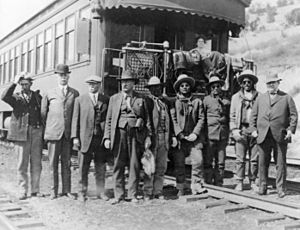Bluff War facts for kids
Quick facts for kids Bluff War |
|||||||
|---|---|---|---|---|---|---|---|
| Part of the Ute Wars, Navajo Wars | |||||||
 Participants in the Bluff War in Thompson, Utah, waiting to board a train for a trial in Salt Lake City. Photo from left to right: Lorenzo Creel, Colonel Michie, General Scott, Marshal Nebeker, Old Polk, Jeff Posey, Chief Posey, Tse-ne-gat, A.B. Apperson. The Indians are wearing dark glasses they had been given. |
|||||||
|
|||||||
| Belligerents | |||||||
| Ute Paiute |
|||||||
| Commanders and leaders | |||||||
| Polk Posey |
|||||||
| Casualties and losses | |||||||
| ~2 killed ~5 wounded |
~2 killed ~2 wounded ~160 captured |
||||||
| Civilian Casualties 2 killed | |||||||
The Bluff War, also known as Posey War of 1915, or the Polk and Posse War, was one of the last armed conflicts between the United States and Ute and Paiute Native Americans (Indians) in Utah. In March 1914, several Utes accused Tse-ne-gat (also known as Everett Hatch), the son of the Paiute Chief Narraguinnep ("Polk"), of murdering a shepherd named Juan Chacon. When a posse attempted to arrest Tse-ne-gat in February 1915, the Paiute and Ute bands headed by Polk and Posey resisted and several people on both sides were killed or wounded. The conflict took place near the town of Bluff, Utah. In March 1915, after negotiations, Polk surrendered Tse-ne-gat to U.S. Army General Hugh L. Scott. In July 1915 he was found innocent of murder in a trial in Denver.
Consequences
Tse-ne-gat died, age 39, of tuberculosis eleven years after the trial. The Ute and Paiute chiefs, Polk and Posey, had pledged to live on the Ute Reservation in Colorado, but unwelcome there and without any means of subsistence they soon returned to a nomadic life. They survived partly on handouts from the people of southeastern Utah and cattle rustling for food. The animosity between Anglo and Indian would eventually result in the so-called Posey War of 1923.


